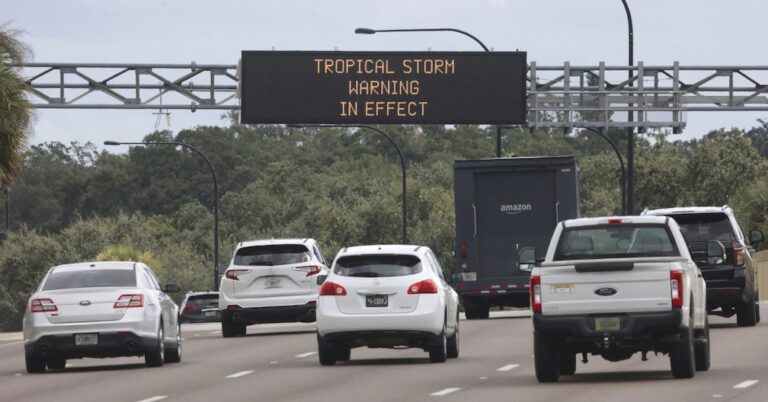TALLAHASSEE, Fla. (AP) — Helene became a hurricane Wednesday after the huge storm rapidly strengthened in the Caribbean Sea and moved north along Mexico’s coast on a path toward the U.S., leading residents to evacuate, schools to close, and officials to declare emergencies in Florida and Georgia.
The storm’s center was near Mexico’s Yucatan Peninsula on Wednesday, the U.S. National Hurricane Center said, and it was expected to intensify and grow in size as it crosses the Gulf of Mexico. Heavy rainfall was forecast for the southeastern U.S. starting Wednesday, with a life-threatening storm surge along the entire west coast of Florida, according to the center.
The storm is so large that areas roughly 90 miles (145 kilometers) north of the Georgia-Florida line could expect hurricane conditions. States as far inland as Tennessee, Kentucky and Indiana could see rainfall. On Wednesday morning, winds of tropical storm force, at least 39 mph (62 kph), extended as far as 275 miles (445 kilometers) from Helene’s center.
“You are going to have a major hurricane plowing inland, and storms take a little time to decay once they’re inland,” said Brian McNoldy, an environmental researcher at the University of Miami.
As residents of Florida’s Big Bend — the curving stretch of Gulf coastline in the state’s north — battened down their homes, many saw the ghost of 2018’s Hurricane Michael. That storm rapidly intensified and crashed ashore as a Category 5 that laid waste to Panama City and parts of the rural Panhandle.
“People are taking heed and hightailing it out of there for higher ground,” said Kristin Korinko, a Tallahassee resident who serves as the commodore of the Shell Point Sailboard Club, on the Gulf Coast about 30 miles (48 kilometers) south of the state capital.
In Tallahassee, where stations had started to run out of gas, 19-year-old at Florida A&M student Kameron Benjamin filled sandbags with his roommate to protect their apartment before evacuating. Their school and Florida State shut down ahead of the storm.
“This hurricane is heading straight to Tallahassee, so I really don’t know what to expect,” Benjamin said.
In the Pacific, former Hurricane John re-formed as a tropical storm Wednesday and threatened areas of Mexico’s western coast anew. John had hit the country’s southern Pacific coast late Monday, killing two people, blowing tin roofs off houses, triggering mudslides and toppling scores of trees, officials said Tuesday.
It grew into a Category 3 hurricane in a matter of hours and made landfall about 80 miles (128 kilometers) east of the resort city of Acapulco. It weakened after moving inland but later reemerged over the ocean.
On Wednesday, officials issued a hurricane watch for the coast from Acapulco to Zihuatanejo and tropical storm warnings from Punta Maldonado to Lazaro Cardenas. John was about 110 miles (180 kilometers) southwest of Acapulco with maximum sustained winds of 40 mph (65 kph) and was moving east at 2 mph (4 kph).
Helene, which formed Tuesday in the Caribbean, is expected to move over deep, warm waters, fueling its intensification. The hurricane was about 500 miles (810 kilometers) southwest of Tampa, Florida, and had top sustained winds of 80 mph (130 kph), according to the hurricane center. Forecasters said it is expected to become a major hurricane with its center making landfall in the Big Bend area of Florida’s northwestern coast as soon as late Thursday.
Mara Lezama, the governor of the coastal Mexican state of Quintana Roo, shared photos of rain-swept streets. In Cancun, heavy waves threatened to worsen the resort city’s problem with beach erosion.
In western Cuba, authorities moved cattle to higher ground and medical brigades were dispatched to communities usually cut off by storms. The government preventively shut off power in some communities as waves as high as 16 feet (5 meters) slammed into Cortes Bay.
The Cayman Islands began recovering after heavy rains and big waves lashed them Tuesday. Schools remained closed Wednesday as flood warnings continued and residents pumped water out of their flooded homes.
Tropical storm warnings were in effect for the upper Florida Keys, southern Florida and the state’s northeast coast and were extended northward Wednesday morning to Altamaha Sound, Georgia. A tropical storm watch was in effect for the South Carolina coast north of the South Santee River to Little River Inlet.
Hurricane watches, a step down from warnings, were also in effect for parts of western Cuba and Florida, including the Tampa Bay area, the hurricane center said.
President Joe Biden declared an emergency in Florida, and federal authorities positioned generators, food and water, along with search-and-rescue and power restoration teams.
Florida Gov. Ron DeSantis, who already issued an emergency for most counties, warned residents Wednesday they needed to heed evacuation orders. A dozen health care facilities including hospitals and nursing homes had evacuated preemptively, DeSantis said.
“There’s clearly a pathway for this to rapidly intensify prior to making landfall,” DeSantis said at a news conference in Tampa.
Georgia Gov. Brian Kemp also declared an emergency in his state. The hurricane warning area included Valdosta, a city of 55,000. Helene approached barely a year after Hurricane Idalia inflicted more than $6 million in damage to 1,000 homes and other property.
Helene is the eighth named storm of the Atlantic hurricane season, which began June 1. Since 2000, eight major hurricanes have made landfall in Florida, according to Philip Klotzbach, a Colorado State University hurricane researcher. The National Oceanic and Atmospheric Administration has predicted an above-average Atlantic hurricane season this year because of record-warm ocean temperatures.
The Associated Press is an independent global news organization dedicated to factual reporting. Founded in 1846, AP today remains the most trusted source of fast, accurate, unbiased news in all formats and the essential provider of the technology and services vital to the news business. The Trucker Media Group is subscriber of The Associated Press has been granted the license to use this content on TheTrucker.com and The Trucker newspaper in accordance with its Content License Agreement with The Associated Press.















